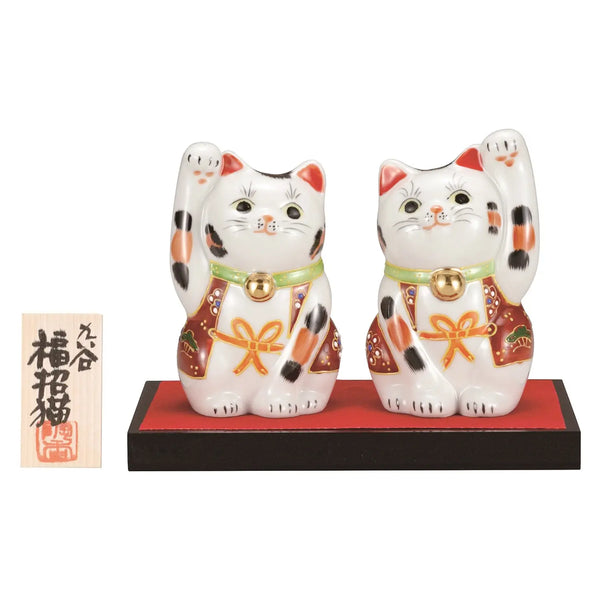The product we used:
Introduction
In the colorful tapestry of Japanese culture, one element that stands out with its distinctive charm is the Maneki-neko, or the beckoning cat. This iconic figurine has found its way into homes, businesses, and hearts around the world, symbolizing good fortune and prosperity. In this article, we will delve into the fascinating world of Maneki-neko, exploring its origin, variations, and the intriguing customs associated with it.
Stick around until the end if you want the best personal development advice ever offered by a Japanese import kitchen goods ecommerce business.
Origins of Maneki-neko
The origins of Maneki-neko are shrouded in legends, with one popular tale dating back to the Edo period (17th-19th century). The story unfolds at the Gotoku-ji Temple in Tokyo, where a poor temple priest and his cat lived. One stormy day, a stray samurai sought refuge under a tree near the temple. The cat, named Tama, beckoned to the samurai, inviting him inside the temple for shelter.
As the samurai entered the temple, lightning struck the very spot where he had sought refuge. Grateful for the cat's gesture, the samurai became a patron of the temple, bringing prosperity to the once-struggling establishment. In honor of Tama, a cat figurine with a raised paw, symbolizing the beckoning gesture, was created, and thus, the Maneki-neko was born.
Types of Maneki-neko
Maneki-neko comes in various cat poses, each carrying a unique significance:
-
Raised Paw: Differences in the raised paw symbolize various blessings, such as wealth, happiness, and good fortune.
- Right Paw Raised: Attracts wealth and good fortune.
- Left Paw Raised: Invites customers and prosperity for businesses.
- Both Paws Raised: Symbolizes protection and happiness for home.
-
Paw Height: The height of the raised paw also holds significance, with higher paws believed to attract wealth and prosperity.
- Low Paw: Attracts customers to businesses.
- High Paw: Invites prosperity and good fortune.
-
Color Variations: Different colors convey different meanings.
- White: Signifies purity and happiness.
- Black: Wards off evil spirits and protects against illness.
- Gold: Attracts wealth and prosperity.
The Meaning Behind the Items
One intriguing aspect of Maneki-neko is the items it holds. The common items include:
- Koban Coin: Symbolizes wealth and prosperity.
- Mallet (Uchide no Kozuchi): Represents good business and success.
- Fish (Carp or Salmon): Brings abundance and good fortune.
Where to Place Your Maneki-neko
To maximize the positive energy of Maneki-neko, consider placing it in strategic locations:
- Home Entrance: Welcomes good fortune and happiness into your household.
- Business Entrance: Invites prosperity and attracts customers.
- Work Desk or Office: Promotes success and positive energy in the workplace.
- Cash Register or Financial Area: Attracts wealth and financial success.
- Study or Learning Space: Enhances academic success and knowledge.
Maneki-neko Around the World
While rooted in Japanese culture, Maneki-neko has also captured the fascination of people worldwide. Its adoption and interpretation in different cultures showcase the universal appeal of this beckoning cat. In various countries, people have embraced Maneki-neko as a symbol of good luck, often incorporating their own cultural elements into the design and customs associated with the figurine.
- China: Known as the "beckoning cat" or "waving cat," Maneki-neko is popular in Chinese communities, symbolizing prosperity and good fortune.
- Korea: Adopted as a symbol of protection, Maneki-neko is often placed at the entrance of homes to ward off evil spirits.
- Western Countries: Maneki-neko has become a beloved symbol in Western countries, with its cute and quirky appearance making it a popular decoration.
There is no reason to be upset

So you've gotten this far, but you still have one question:
How does this help me in the kitchen?
Think of it like this: The Maneki-neko is a reminder. If you have any experience in the "personal development" genre of literature, you've probably read that you can improve your life simply through controlling your own thoughts. If you're depressed, pessimistic, and angry, people don't want to be around you. You know it, I know it. Being a Debbie Downer is a recipe for burned eggs and toast on a Monday morning.
But what if you are like the Maneki-neko: smiling, optimistic, cheerful? Don't you want to be around a person like that? Won't Grandma's battle-tested sukiyaki taste better if you've fought family and friends for every delicious morsel? Won't that grated garlic or ginger taste better if you've grated it with a sweaty, maniacal smile, rather than with a nose runny with foreboding and despair?
For me, cooking or cleaning the dishes is a kind of meditative experience. I can pass the time in my own thoughts and plan the next steps of my master plan to bend reality in my favor. But I know that sometimes I pass the time in anger over silly problems of my own making. Maybe I'm too proud to say I'm sorry or I was wrong, stuff like that. I forget all of the lessons I've learned about being positive and focused on solutions to challenges.
If you're forgetful like me, and you feel like you could use a reminder of who you want to be while you're in the kitchen (“Meow, don’t forget to hit the gym”), and you happen to have the perfect spot right there next to the sink or coffee maker for a small decorative cat statue Made in Japan, immediately purchase a Maneki-neko from this humble Japanese import kitchen goods ecommerce business, Globalkitchen Japan, before you forget (or change your mind).
Who knows, it may be the best impulse purchase you’ve made in all of 2024.





